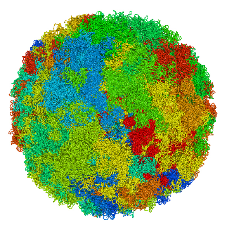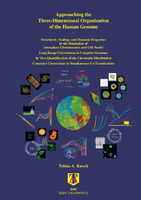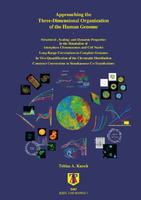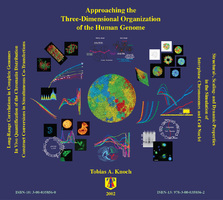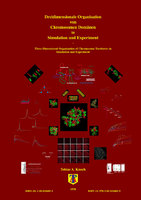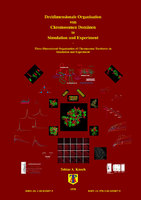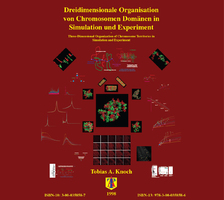Welcom to my Science and Art website!
Currently you find here my PhD and Diploma thesis - see below...
My PhD thesis:
Approaching the three-dimensional organization of the human genome: structural-, scaling- and dynamic properties in the simulation of interphase chromosomes and cell nuclei, long-range correlations in complete genomes, in vivo quantification of the chromatin distribution, construct conversions in simultaneous co-transfections. Dissertation, Ruperto-Carola University, Heidelberg, Germany, and TAK Press, Mannheim, Germany, 2002.
ISBN-10: 3-00-009959-X and ISBN-13: 978-3-00-009959-5 (softcover).
ISBN-10: 3-00-009960-1 and ISBN-13: 978-3-00-009960-1 (hardcover).
ISBN-10: 3-00-035856-0 and ISBN-13: 978-3-00-035856-2 (DVD).
It is available online for download here:
PDF-Dokument [63.4 MB]
and is also available globally in print and on DVD:
Softcover:
ISBN-10: 3-00-009959-X 300009959X
ISBN-13: 978-3-00-009959-5 9783000099595
Hardcover:
ISBN-10: 3-00-009960-3 3000099603
ISBN-13: 978-3-00-009960-1 9783000099601
DVD:
ISBN-10: 3-00-035856-0 3000358560
ISBN-13: 978-3-00-035856-2 9783000358562
It deals with (abstract):
To approach the still largely unknown sequential and three-dimensional organization of the human cell nucleus, the structural-, scaling- and dynamic properties of interphase chromosomes and cell nuclei were simulated on the 30 nm chromatin fiber level with Monte Carlo, Brownian Dynamics and parallel computing methods. Differences between used models explain various experimental conditions, favouring a Multi-Loop-Subcompartment model with 63-126 kbp loops aggregated to possibly rosettes connected by 63-126 kbp linkers, and predict correctly the transport of molecules by moderately obstructed diffusion excluding the Interchromosomal Domain hypothesis. Correlation analyses of completely sequenced Archaea, Bacteria and Eucaria chromosomes revealed fine-structured positive long-range correlations due to codon, nucleosomal or block organization of the genomes, allowing classification and tree construction. By construction and expression of fusionproteins from the histones H1, H2A, H2B, H3, H4 and mH2A1.2 with the autofluorescent proteins CFP, GFP, YFP, DsRed-1 and DsRed-2 the chromatin morphology could be investigated in vivo during interphase, mitosis or apoptosis and revealed different interphase morphologies for cell lines quantifiable by scaling analyses. Finally, construct conversions in simultaneous co-transfections due to recombination/repair/replication were discovered in 25 % of cells and led to a variety of new applications.
Keywords:
chromatin fiber, chromosome territories, nuclear structure/ organization,
interphase cell nucleus, mitosis, apoptosis, nucleoplasma, scaling/ fractal analysis, exact yard-stick dimension, box-counting dimension, lacunarity dimension, local nuclear dimension, nuclear diffuseness, anomalous diffusion, percolation, Monte Carlo, Brownian Dynamics, parallel computing, DNA sequence, complete sequenced genomes, long-range correlations, genome organization, phylogenetic trees, histones, H1.0, H2A, H2B, H3, H4, mH2A1.2, autofluorescent proteins (CFP, GFP, YFP, DsRed), fusionprotein, in vivo labelling, chromatin density distribution, homologous recombination, repair, replication, simultaneous co-transfection.
My Diploma thesis:
Dreidimensionale Organisation von Chromosomen Domänen in Simulation und Experiment - Three-Dimesional Organization of Chromosome Territories in Simulation and Experiment. Diploma Thesis, Ruperto-Carola University, Heidelberg, Germany, and TAK Press, Mannheim, Germany, 1998.
ISBN-10: 3-00-010685-5 and ISBN-13: 978-3-00-010685-9 (softcover).
ISBN-10: 3-00-035857-9 and ISBN-13: 978-3-00-035857-9 (hardcover).
ISBN-10: 3-00-035858-7 and ISBN-13: 978-3-00-035858-6 (DVD).
It is available online for download here:
PDF-Dokument [42.3 MB]
and is also available globally in print and on DVD:
Softcover:
ISBN-10: 3-00-010685-5 3000106855
ISBN-13: 978-3-00-010685-9 9783000106859
Hardcover:
ISBN-10: 3-00-0355857-0 30003558570
ISBN-13: 978-3-00-035857-9 9783000358579
DVD:
ISBN-10: 3-00-035858-7 3000358587
ISBN-13: 978-3-00-035857-6 9783000358586
It deals with (Zusammenfassung in German and abstract in English):
Zusammenfassung:
Um Aussagen über die dreidimensionale Organisation von Chromosomen in der Interphase zu machen, wurden Monte-Carlo und Brownsche-Dynamik Simulationen von Chromosomenterritorien mit Hilfe eines Polymeransatzes durchgeführt. Daraus wurden Observable (verschiedene Abstandsverteilungen zwischen genomischen Markern, Aufenthaltswahrscheinlichkeit und Dichte) berechnet, die für die Vorhersage und Interpretation von Experimenten dienen. Damit können Modelle der chromosomalen Organisation, insbesondere das Random-Walk/Giant-Loop- (MLS) und das Multi-Loop-Subcompartment Modell, unterschieden werden.
Für die Bestimmung von Abstandsverteilungen zwischen genomischen Markern der Prader-Labhart-Willi/ Angelmann (PLW/A) Region wurden Experimente mit einem konfokalen Laser-Scanning-Mikroskop (CLSM) durchgeführt. Zellkerne von Fibroblasten wurden mit schonender Fluoreszenz in situ Hybridisierung (FISH) präpariert. Über die Signal-Brightness, das Signalvolumen, die Intergrierte Fluoreszenz Intensität (IFI) und den Abstand homologer Chromosomen wurden ebenfalls Aussagen gemacht.
Vergleiche zwischen Simulation und Experiment ergaben starke Hinweise für das MLS Modell, sowie eine unterschiedliche Organisation zwischen mütterlichem und väterlichem Chromosom 15.
Im Hinblick auf zukünftige komplexere Fragestellungen der Gesamtorganisation des Zellkerns stellte sich die Theorie der Fraktale für neue Analysemethoden als geeignet heraus. Die Ergebnisse der Simulationen zeigten dabei multifraktales Verhalten. Erstmals könnte damit die Fraktalität und Multifraktalität einer zellulären Organisationsstruktur gezeigt worden sein. Damit besteht nun die Möglichkeit aus der fraktalen Struktur Aussagen über Diffusionseigenschaften und andere Organisationsmerkmale im Zellkern zu treffen.
Abstract:
To draw conclusions about the three-dimensional organization of interphase chromosomes, Monte-Carlo and Brownian-Dynamic simulations of chromosomal territories were conducted, using a polymer model for the chromatin fiber. From the simulated configuration ensembles observables (various distance distributions between genomic markers, radial space distribution and density) were calculated and used for predictions and interpretation of experiments. It was possible to distinguish between different models of chromosomal organization, especially between the Random-Walk/Giant-Loop (RWGL) and the Multi-Loop-Subcompartment model.
For the determination of distance distributions between genomic markers of the Prader-Labhart-Willi/Angelmann region (PLW/A) experiments were made with a confocal Laser-Scanning-Microscope (CLSM). Cell nuclei of fibroblast cells were prepared with soft Fluorescence in situ Hybridization (FISH). Conclusions can be drawn from the signal-brightness, signal-volume, Integrated Fluorescent Intensity (IFI) and the distance between homologous chromosomes.
Comparisons between simulation and experiment lead to strong hints for the MLS model, as well as a different organization of maternal and paternal chromsome15.
With respect to future aspects of more complex questions on the total organization of cell nuclei the theory of fractals proved very worthwhile for new methods of analysis. The results of the simulations thereby showed multi-fractal behaviour. Thus, for the first time the fractal and multi-fractal behaviour of a cellular organization structure was determined. Consequently possibilities exist to draw conclusions from the fractal structure for the diffusion behaviour and other organizational patterns of the cell nucleus.
Schlagwörter:
Genetik, Genom, Chromosomen Domänen/Territorien, Zellkern Struktur/Organisation, Chromatin Faser, Skalierungs/Fraktale Analyse, Brownsche Dynamik, Monte Carlo, Paralleles Rechnen, Fluoreszenz in situ Hybridisierung, Konvokale Laser Scanning Mikroskopie, Räumliche Abstandsmessung.
Keywords:
genetics, genome, chromosome territories, nuclear structure/organization, chromatin fiber, scaling/fractal analysis, Brownian Dynamics, Monte Carlo, parallel computing, fluoreszence in situ hybridisation, convocal laser scanning microscopy, spatial distance measurement.
